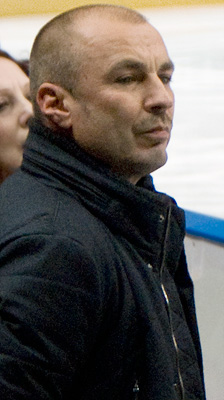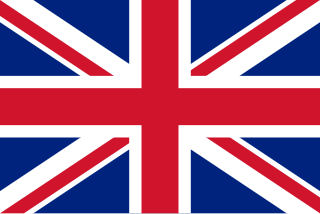
The 1908 Summer Olympics was an international multi-sport event held from 27 April to 31 October 1908, in London, United Kingdom, coinciding with the Franco-British Exhibition.
Three figure skating events were contested at the 1920 Summer Olympics in Antwerp, but they were held in April 1920, four months before most of the other Olympic events at the 1920 Games. The figure skating competition took place at the Ice Palace of Antwerp.

Alexander (Sasha) Viacheslavovich Zhulin is a Russian ice dancing coach and former competitor. With Maya Usova, he is a two-time Olympic medalist, the 1993 World champion, and the 1993 European champion. They also won gold medals at Skate America, NHK Trophy, Nations Cup, and Winter Universiade. They represented the Soviet Union, the Unified Team, and Russia.

Maya Valentinovna Usova is a Russian former ice dancer. With Alexander Zhulin, she is a two-time Olympic medalist, the 1993 World champion, and the 1993 European champion. They also won gold medals at Skate America, NHK Trophy, Nations Cup, and Winter Universiade. They represented the Soviet Union, the Unified Team, and Russia.

France competed at the 1920 Summer Olympics in Antwerp, Belgium. 304 competitors, 296 men and 8 women, took part in 113 events in 23 sports.
The men's singles was one of four events in figure skating at the 1908 Summer Olympics. Each nation could enter up to 3 skaters. Sweden's Ulrich Salchow, who had won several World Figure Skating Championships, easily won the gold medal after his main rival, Russia's Nikolai Panin, withdrew either in protest over what he considered unfair judging or due to illness.
The men's special figures was one of four events in figure skating at the 1908 Summer Olympics. Each nation could enter up to 3 skaters. Gold medalist Nikolai Panin's real name was Nikolai Kolomenkin, but he competed under the pseudonym "Panin".
The ladies' singles was one of four events in figure skating at the 1908 Summer Olympics. Each nation could enter up to 3 skaters. Without rivals Jenny Herz and Lily Kronberger present at the Olympics, Great Britain's Madge Syers easily won the gold medal.

The men's individual trap shooting competition was one of 15 shooting sports events on the Shooting at the 1908 Summer Olympics programme. It was held from 8 to 11 July. Each nation could enter up to 12 shooters. There were 61 competitors from 8 nations. Canada took the top two spots, with Walter Ewing earning gold and George Beattie silver. There were two bronze medals awarded after Alexander Maunder of Great Britain and Anastasios Metaxas of Greece tied for third place. The medals were the first in the event for all three nations. Ewing also received Lord Westbury's Cup as a challenge prize.
The men's 10 metre platform, also known as the high diving competition, was one of two diving events on the diving at the 1908 Summer Olympics programme, along with the men's 3 metre springboard. The competition was held from Monday 20 to Friday 24 July 1908. Twenty-four divers from six nations competed. Each nation could enter up to 12 divers.
The men's 3 metre springboard, also known as the fancy diving competition, was one of two diving events on the Diving at the 1908 Summer Olympics programme, along with the men's 10 metre platform. The competition was held on Tuesday 14 and Saturday 18 July 1908. Twenty-three divers from eight nations competed. Each nation could enter up to 12 divers.

Great Britain, represented by the British Olympic Association (BOA), competed at the 1912 Summer Olympics in Stockholm, Sweden. 274 competitors, 264 men and 10 women, took part in 79 events in 16 sports. British athletes won ten gold medals and 41 medals overall, finishing third.
The men's 3 metre springboard, also known as the spring-board diving competition, was one of four diving events on the diving at the 1912 Summer Olympics programme. The competition was held on Monday 8 July 1912, and Tuesday 9 July 1912. Eighteen divers from seven nations competed.

The men's plain high diving was one of four diving events on the diving at the 1912 Summer Olympics programme. The competition was held on Saturday 6 July 1912, on Sunday 7 July 1912, and on Thursday 11 July 1912. Thirty-one divers from nine nations competed.

The men's 10 metre platform, also known as plain and variety diving combined competition, was one of four diving events on the Diving at the 1912 Summer Olympics programme. The competition was held from Friday 12 July 1912 to Monday 15 July 1912. Twenty-three divers from seven nations competed.
The pair skating event held as part of the figure skating at the 1920 Summer Olympics. It was the second appearance of the pair skating event and the sport, which had previously been held in 1908. Eight pairs from six nations competed. Bronze medalist Phyllis Johnson had captured the silver medal at the 1908 Olympics with a different partner.
The Olympic medal table is a method of sorting the medal placements of countries in the modern-day Olympics and Paralympics. The International Olympic Committee (IOC) does not officially recognize a ranking of participating countries at the Olympic Games. Nevertheless, the IOC does publish medal tallies for information purposes, showing the total number of Olympic medals earned by athletes representing each country's respective National Olympic Committee. The convention used by the IOC is to sort by the number of gold medals the athletes from a country have earned. In the event of a tie in the number of gold medals, the number of silver medals is taken into consideration, and then the number of bronze medals. If two countries have an equal number of gold, silver, and bronze medals, they are ordered in the table alphabetically by their IOC country code.
The women's single skating competition of the 1960 Winter Olympics was held at the Blyth Arena in Squaw Valley, California, United States. The compulsory figures section took place on Sunday 21 February 1960 with the free skating section concluding the event two days later. Each judge ranked each skater by Ordinal Placement from first to last place. If a skater was ranked first by a majority of the judges, that skater was placed first overall, this process was repeated for each place. If more than one skater had a majority ranking for the same position then a series of tiebreaks were in place, indicated in order in the result section.
The pair skating competition of the 1960 Winter Olympics was held at the Blyth Arena in Squaw Valley, California, United States. The event took place on Friday 19 February 1960. Each judge ranked the skaters by Ordinal Placement from first to last place. If a skater was ranked first by a majority of the judges, that skater was placed first overall; this process was repeated for each place. If more than one skater had a majority ranking for the same position, then a series of tiebreaks were in place, indicated in order in the Results section below.








